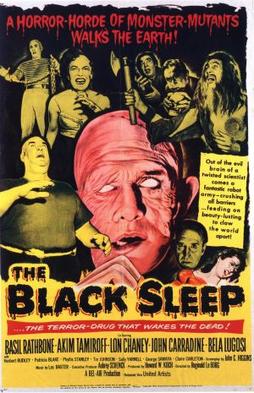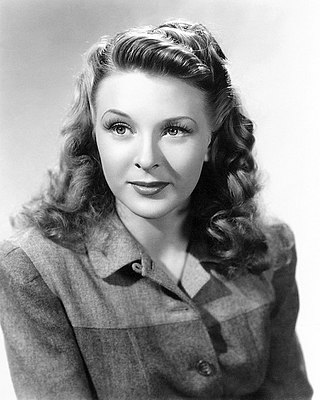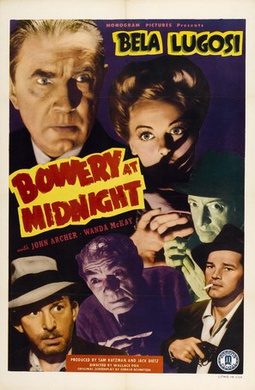
Béla Ferenc Dezső Blaskó, known professionally as Bela Lugosi, was a Hungarian–American actor, best remembered for portraying Count Dracula in the 1931 horror classic Dracula, Ygor in Son of Frankenstein (1939) and his roles in many other horror films from 1931 through 1956.
Scared to Death is a 1947 American gothic thriller film directed by Christy Cabanne and starring Bela Lugosi, George Zucco, Nat Pendleton and Molly Lamont. The picture was filmed in Cinecolor. The film is historically important as the only color film in which Bela Lugosi has a starring role. Lionel Atwill was originally slated to appear in the film, but he was too ill to work, so George Zucco replaced him in the cast. Christy Cabanne completed the film in early 1946, but it wasn't screened until 1947.
The year 1943 in film featured various significant events for the film industry.

Dracula is a 1931 American pre-Code supernatural horror film directed and co-produced by Tod Browning from a screenplay written by Garrett Fort and starring Bela Lugosi in the title role. It is based on the 1924 stage play Dracula by Hamilton Deane and John L. Balderston, which in turn is adapted from the 1897 novel Dracula by Bram Stoker. Lugosi portrays Count Dracula, a vampire who emigrates from Transylvania to England and preys upon the blood of living victims, including a young man's fiancée.

White Zombie is a 1932 pre-Code horror film independently produced by Edward Halperin and directed by Victor Halperin. The screenplay by Garnett Weston, based on The Magic Island by William Seabrook, is about a young woman's transformation into a zombie at the hands of an evil voodoo master. Bela Lugosi stars as the zombie master "Murder" Legendre, with Madge Bellamy appearing as his victim. Other cast members include Joseph Cawthorn, Robert W. Frazer, John Harron, Brandon Hurst, and George Burr MacAnnan.

The Black Sleep is a 1956 American independent horror film directed by Reginald LeBorg, and written by John C. Higgins from a story by Gerald Drayson Adams. It stars Basil Rathbone, Lon Chaney Jr., John Carradine, Bela Lugosi, and Akim Tamiroff. Tor Johnson appears in a supporting role. The film was produced by Aubrey Schenck and Howard W. Koch, as part of a four-picture finance-for-distribution arrangement with United Artists.

Invisible Ghost is a 1941 American horror film directed by Joseph H. Lewis, produced by Sam Katzman and starring Bela Lugosi.

Black Friday is a 1940 American science fiction horror film starring Boris Karloff and Bela Lugosi.

House of Frankenstein is a 1944 American horror film starring Boris Karloff, Lon Chaney Jr. and John Carradine. Based on a story by Curt Siodmak, it was directed by Erle C. Kenton and produced by Universal Pictures. The film is about Dr. Gustav Niemann, who escapes from prison and promises to create a new body for his assistant Daniel. Over the course of the film, they encounter Count Dracula, Larry Talbot, the Wolf Man, and Frankenstein's Monster.

Evelyn Felisa Ankers was a British-American actress who often played variations on the role of the cultured young leading lady in many American horror films during the 1940s, most notably The Wolf Man (1941) opposite Lon Chaney Jr., a frequent screen partner.

The Mad Ghoul is a 1943 American horror film directed by James Hogan and starring Turhan Bey, Evelyn Ankers, and David Bruce, and featuring George Zucco, Robert Armstrong, and Milburn Stone. The film is about the scientist Dr. Alfred Morris and his assistant Ted Allison. Morris, who is obsessed with an ancient Mayan life-preserving process to the point of madness, has fallen in love with Allison's girlfriend, the concert singer Isabel Lewis. Morris decides to use Allison for his eternal-life experiments, transforming him into a zombie who slowly recalls his past life, but is unaware of his undead status.

George Zucco was a British character actor who appeared in plays and 96 films, mostly American-made, during a career spanning over two decades, from the 1920s to 1951. In his films, he often played a suave villain, a member of nobility, or a mad doctor.

Murders in the Rue Morgue is a 1932 American horror film directed by Robert Florey, based on Edgar Allan Poe's 1841 short story "The Murders in the Rue Morgue". The plot is about Doctor Mirakle, a carnival sideshow entertainer and scientist who kidnaps Parisian women to mix their blood with that of his gorilla, Erik. As his experiments fail because of the quality of his victims' blood, Mirakle meets with Camille L'Espanye, and has her kidnapped and her mother murdered, leading to suspicion falling on Camille's fiance, Pierre Dupin, a medical student who has already become interested in the earlier murders.

King of the Zombies is a 1941 American zombie comedy film directed by Jean Yarbrough and starring Dick Purcell, Joan Woodbury, and Mantan Moreland. The film was produced by Monogram Pictures, and was typical of its B films produced by the Pine-Thomas team. Along with flying scenes, the use of zany characters and slapstick efforts were juxtaposed with a spy and zombie story.

Francis Charles Moran was an American boxer and film actor who fought twice for the Heavyweight Championship of the World, and appeared in over 135 movies in a 25-year film career.

The Ape Man is a 1943 American horror film directed by William Beaudine. The film is based on "They Creep in the Dark" by Karl Brown, which was published in The Saturday Evening Post. It stars Bela Lugosi as Dr. James Brewster who is aided by his colleague Dr. Randall. The doctor manages to transform himself into a ape man hybrid and desperately seeks a cure. Brewster believes that only the injection of human spinal fluid will prove effective as a cure. As Randall refuses to help him, Brewster and his captive gorilla seek involuntary donors.

Bowery at Midnight is a 1942 American Monogram Pictures horror film directed by Wallace Fox and starring Bela Lugosi and John Archer. The film was re-released by Astor Pictures in 1949.
Revenge of the Zombies is a 1943 horror film directed by Steve Sekely, starring John Carradine and Gale Storm. Dr. Max Heinrich von Altermann, is a mad scientist working to create a race of living dead warriors for the Third Reich.

Return of the Ape Man is a 1944 American film distributed by Monogram Pictures. It was directed by Philip Rosen with top-billed star Bela Lugosi and supporting actors John Carradine, George Zucco, Frank Moran, Judith Gibson and Michael Ames.

Murder Legendre is a fictional character and the antagonist of the 1932 black-and-white horror film White Zombie where he was portrayed by actor Bela Lugosi. A malevolent voodoo and zombie master with telepathic powers, this character is remembered as one of the actor's most striking performances and has been the subject of various interpretations.

















